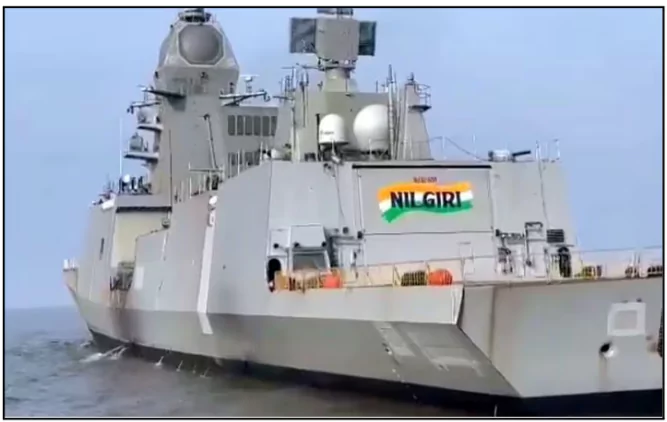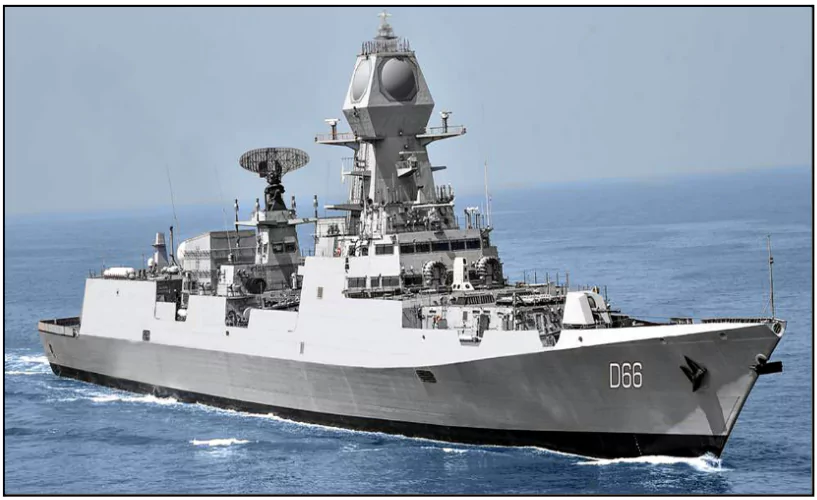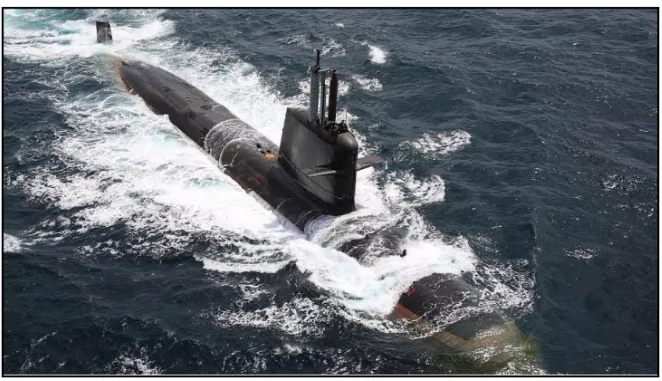For the first time in Indian Navy history, a frigate, a destroyer, and a submarine were commissioned on the same day, marking a significant leap toward achieving self-reliance under the “Atma Nirbhar Bharat” initiative.
The platforms commissioned were
- Frigate: INS Nilgiri
- Destroyer: INS Surat
- Submarine: INS Vaghsheer
Enroll now for UPSC Online Course
About INS Nilgiri

- It is a Frigate.
- Class: Nilgiri-class stealth frigate
- Built Under: Project 17A, a follow-on project of the Shivalik-class frigates currently in service.
- Key Features
- First of seven frigates in Project 17A.
- Built by Mazagon Dock Shipbuilders Limited (MDL), Mumbai, and Garden Reach Shipbuilders and Engineers (GRSE), Kolkata.
- Equipped with:
- Supersonic surface-to-surface missiles.
- Medium Range Surface-to-Air Missiles (MRSAM).
- Role: Critical for anti-surface, anti-air, and anti-submarine warfare missions.
INS Surat

- Type: Guided missile destroyer
- Class: Fourth and final stealth guided missile destroyer under Project 15B, following INS Visakhapatnam, INS Mormugao, and INS Imphal.
- Key Features
- First Indian Navy warship to integrate artificial intelligence (AI) for enhanced operational efficiency.
- Built by Mazagon Dock Shipbuilders Limited (MDL).
- Armed with state-of-the-art weapons, including:
- Surface-to-air missiles.
- Anti-ship missiles.
- Torpedoes.
INS Vaghsheer

- It is a Submarine
- Class: Sixth and final submarine of the Kalvari-class built under Project 75.
- Designed and Developed By: French defence major Naval Group and Spanish state-owned entity Navantia.
- Key Features
- Diesel-electric propulsion system.
- Equipped with advanced Air Independent Propulsion (AIP) systems (to be installed from 2026) for extended underwater endurance.
- Designed for anti-surface and anti-submarine warfare, intelligence gathering, area surveillance, and special operations.
- Naming: Named after Vaghsheer, a type of sandfish found in the Indian Ocean.
Check Out UPSC Modules From PW Store
Comparison of Frigate, Destroyer, and Submarine
| Aspect |
Frigate |
Destroyer |
Submarine |
| Overview |
Medium-sized, versatile warship. |
High-speed, heavily armed warship. |
Underwater vessel capable of stealth missions. |
| Primary Role |
Defensive, anti-submarine warfare (ASW), escort missions. |
Offensive, frontline combat, multi-threat engagement. |
Stealth operations, intelligence gathering, offensive strikes. |
| Environment |
Operates in coastal and blue-water regions. |
Primarily blue-water operations. |
Operates underwater in littoral and deep-sea areas. |
| Capabilities |
Multi-role: ASW, anti-air, escort. |
Anti-ship, anti-air, anti-submarine warfare. |
Anti-ship, anti-submarine warfare, land-attack missile capability. |
| Size & Power |
Smaller, less powerful than destroyers. |
Larger and more powerful than frigates. |
Compact but powerful, with underwater capabilities. |
| Examples (Indian Navy) |
INS Talwar, INS Shivalik |
INS Kolkata, INS Delhi |
INS Kalvari (Scorpene-class), INS Chakra (Nuclear-powered). |
| Weapons & Systems |
Medium-range weapons, torpedoes, surface-to-air missiles (SAM). |
Long-range missiles, heavy artillery, advanced radars. |
Torpedoes, cruise missiles, stealth technology. |
| Crew Size |
Smaller crew (150–200 personnel). |
Larger crew (300–400 personnel). |
Smaller crew due to compact design (30–100 personnel). |
Enroll now for UPSC Online Classes
Significance of the Commissioning
- Showcasing Indigenous Capability: The tri-commissioning of INS Surat, INS Nilgiri, and INS Vaghsheer underscores India’s advancements in indigenous defense manufacturing highlighting the success of Atma Nirbhar Bharat (self-reliant India) in the defense sector.
- The level of indigenisation on all the three platforms is more than 70%.
- Boosting Strategic Deterrence: Adds to India’s deterrence against regional threats and potential adversaries.
- Reinforces the Navy’s ability to protect trade routes and national interests in contested waters.
- Enhancing Blue-Water Capabilities: The platforms expand the Navy’s capacity to operate in open ocean environments far from the coast.
- Supports extended deployments and power projection in the Indo-Pacific region and beyond.
- A Blue Water Navy is one that has the capacity to project itself over a much bigger maritime area than its maritime borders. Simply put, it is a Navy that can go into the vast, deep oceans of the world
- Strengthening Network-Centric Warfare: Incorporation of advanced sensors, AI, and network-centric systems in these vessels enhances operational efficiency and combat readiness.
- Supporting Multi-Dimensional Warfare: Provides the Navy with capabilities for anti-surface, anti-air, and anti-submarine warfare, along with intelligence gathering and special operations.
- Strengthens the Navy’s ability to respond to both conventional and unconventional threats.
- Geopolitical Significance: Reflects India’s emergence as a key maritime power and a responsible regional player in ensuring peace and stability in the IOR.
- Increases global trust in India’s capability as a “first responder” in the region during crises.
Additional Reading: Project 75, Project 15 B, Project 17 A
![]() 16 Jan 2025
16 Jan 2025





